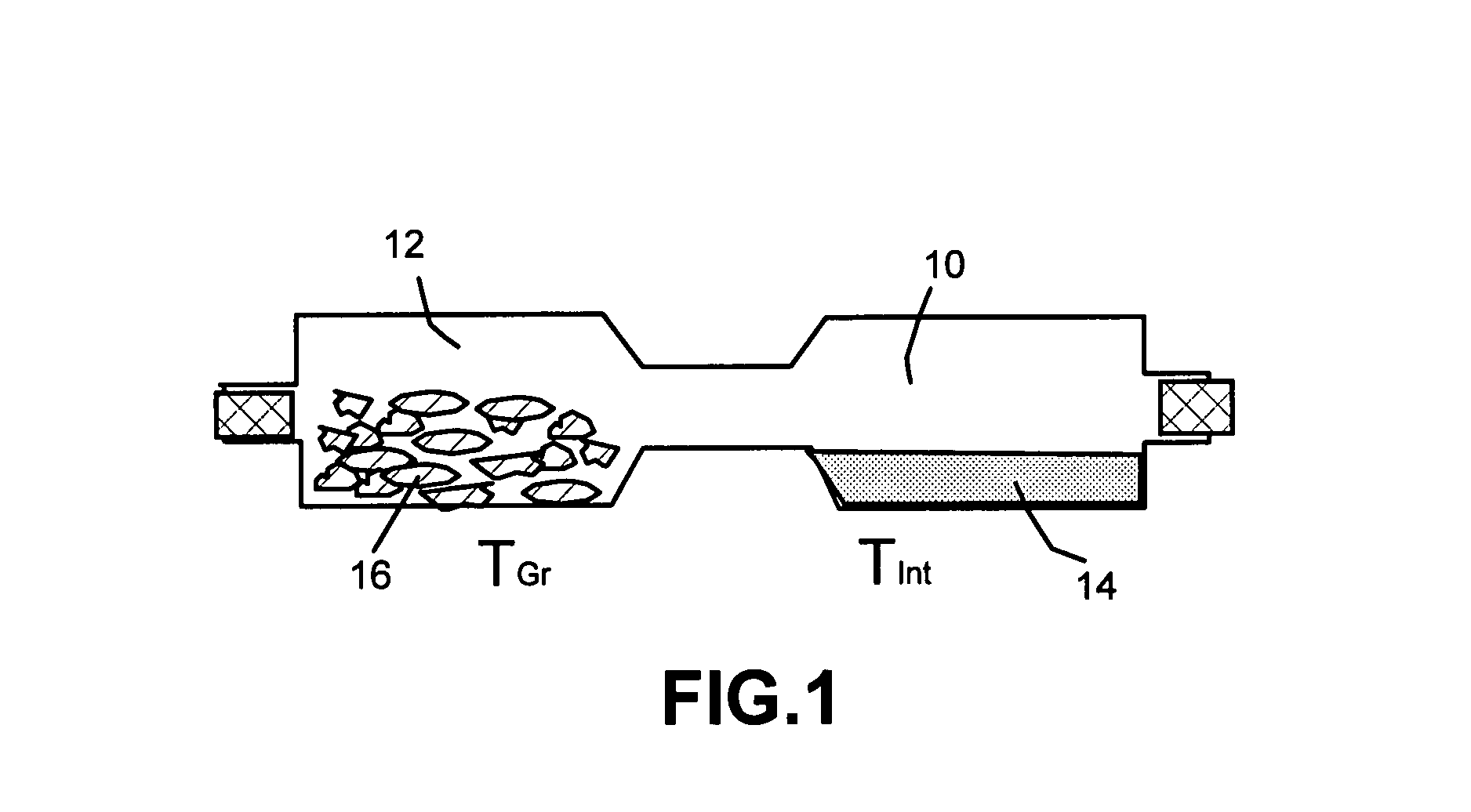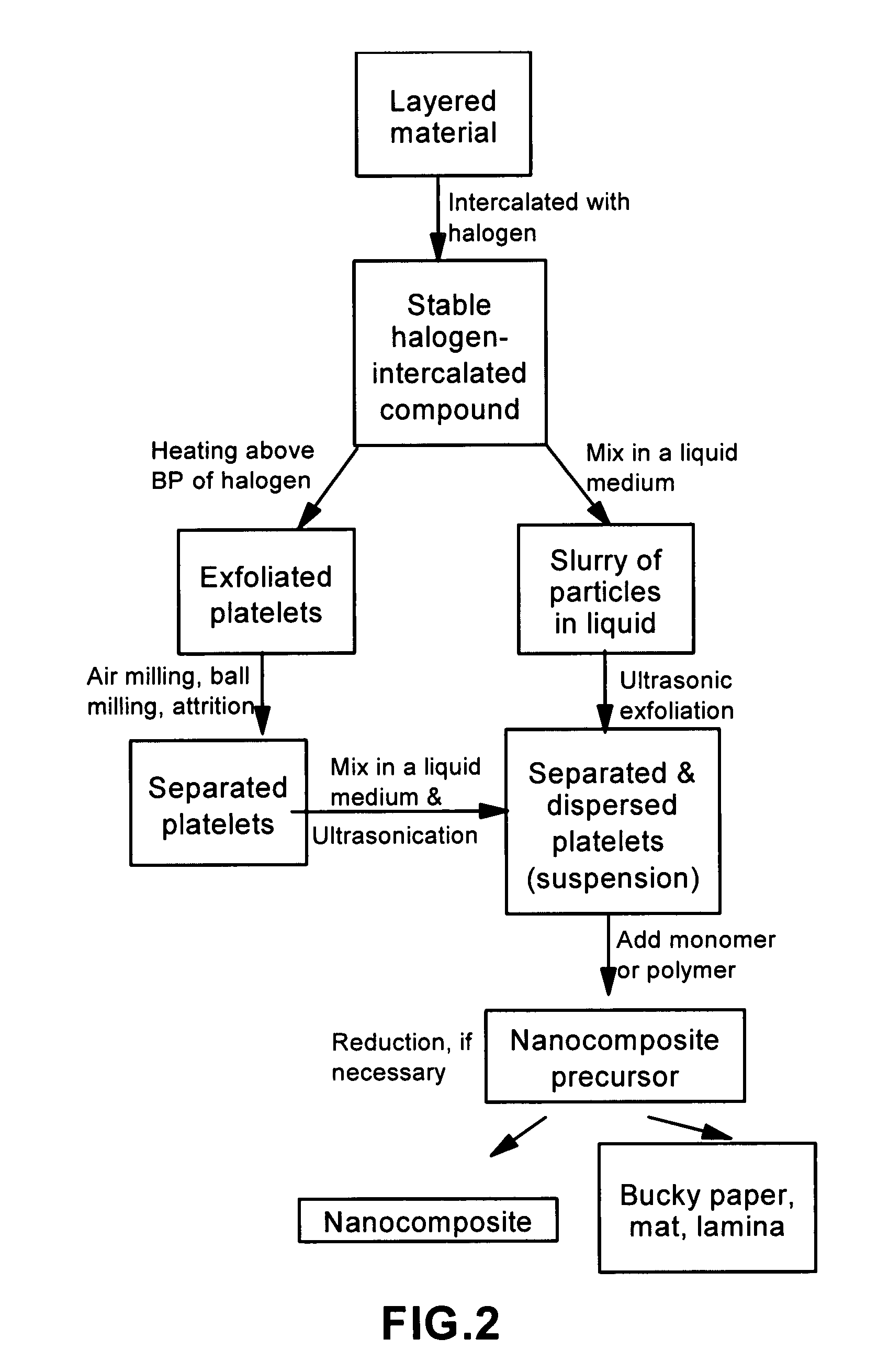Method of producing nano-scaled graphene and inorganic platelets and their nanocomposites
a nano-scale graphene and inorganic platelet technology, applied in the direction of copper oxide/halide, chromium oxide/hydrate, energy-based chemical/physical/physicochemical processes, etc., can solve the problems of high material cost, affecting the widespread application of cnts, and tedious washing steps, so as to reduce the potential impact of halogen on the environment, the effect of being easily captured and re-used
- Summary
- Abstract
- Description
- Claims
- Application Information
AI Technical Summary
Benefits of technology
Problems solved by technology
Method used
Image
Examples
example 1
Nano-Scaled Graphene Platelets (NGPs) from Highly Oriented Pyrolytic Graphite (HOPG) Flakes
[0058]One hundred grams of HOPG flakes, ground to approximately 20 μm or less in sizes, and a proper amount of bromine liquid were sealed in a two-chamber quartz tube (schematically shown in FIG. 1) with the HOPG chamber controlled at 25° C. and bromine at 20° C. for 48 hours to obtain a halogen-intercalated graphite compound.
[0059]Subsequently, approximately ⅔ of the intercalated compound was transferred to a furnace pre-set at a temperature of 200° C. for 30 seconds. The compound was found to induce extremely rapid and high expansions of graphite crystallites with an expansion ratio of greater than 300. The thickness of individual platelets ranged from single graphene sheet to approximately 2-20 graphene sheets. A small portion of the exfoliated graphite particles were then ball-milled in a high-energy plenary ball mill machine for 24 hours to produce nano-scaled particles with reduced lengt...
example 2
NGPs from Short Carbon Fiber Segments
[0061]The procedure was similar to that used in Example 1, but the starting material was carbon fibers chopped into segments with 0.2 mm or smaller in length prior to the halogen vapor (Br2) intercalation treatment. The diameter of carbon fibers was approximately 12 μm. Great expansions were achieved after exposure to heat at 200° C.
example 3
NGPs from Graphitic Nano-Fibers (GNFs)
[0062]A powder sample of graphitic nano-fibers was prepared by introducing an ethylene gas through a quartz tube pre-set at a temperature of approximately 800° C. Also contained in the tube was a small amount of nano-scaled Cu—Ni powder supported on a crucible to serve as a catalyst, which promoted the decomposition of the hydrocarbon gas and growth of GNFs. Approximately 2.5 grams of GNFs (diameter of 10 to 80 nm) were intercalated with ICl vapor at 70° C. for 48 hours. The sample was then heated to approximately 250° C. to effect rapid exfoliation.
PUM
| Property | Measurement | Unit |
|---|---|---|
| thickness | aaaaa | aaaaa |
| boiling point | aaaaa | aaaaa |
| thickness | aaaaa | aaaaa |
Abstract
Description
Claims
Application Information
 Login to View More
Login to View More - R&D
- Intellectual Property
- Life Sciences
- Materials
- Tech Scout
- Unparalleled Data Quality
- Higher Quality Content
- 60% Fewer Hallucinations
Browse by: Latest US Patents, China's latest patents, Technical Efficacy Thesaurus, Application Domain, Technology Topic, Popular Technical Reports.
© 2025 PatSnap. All rights reserved.Legal|Privacy policy|Modern Slavery Act Transparency Statement|Sitemap|About US| Contact US: help@patsnap.com



